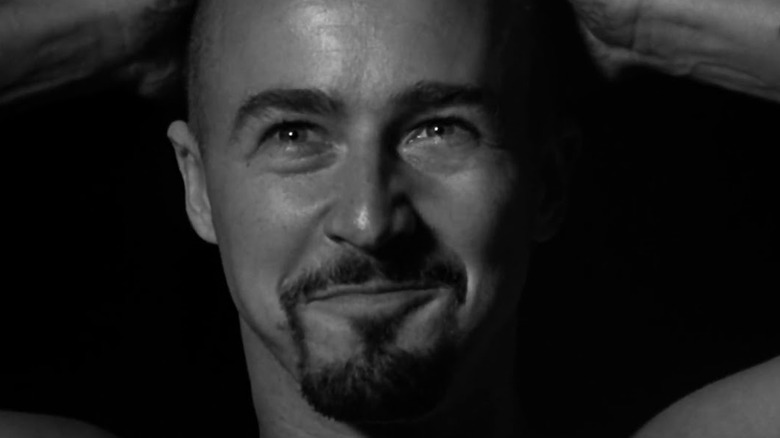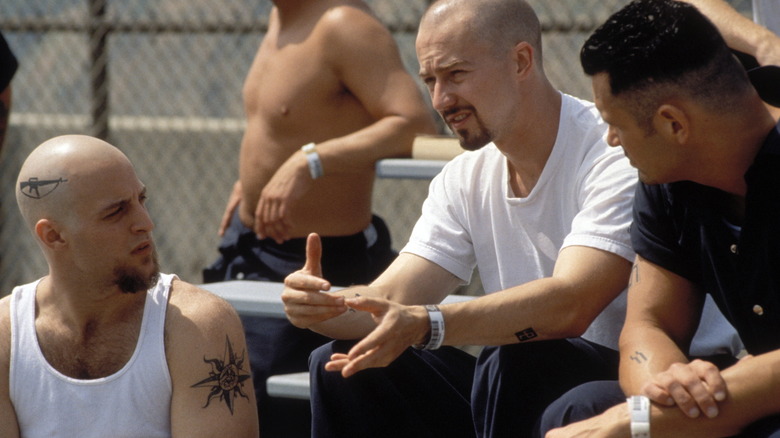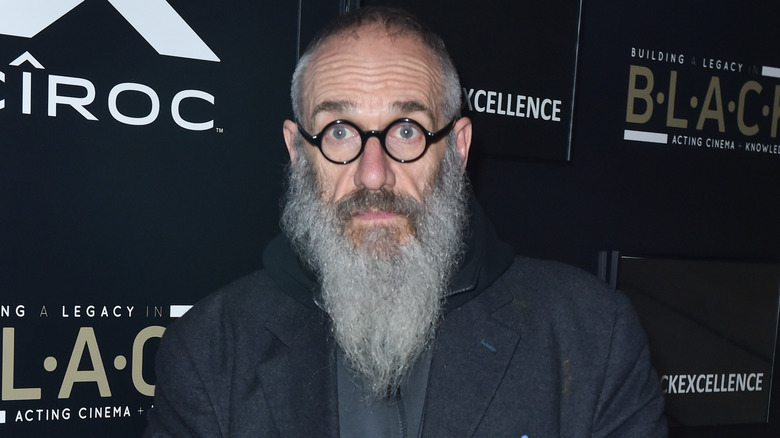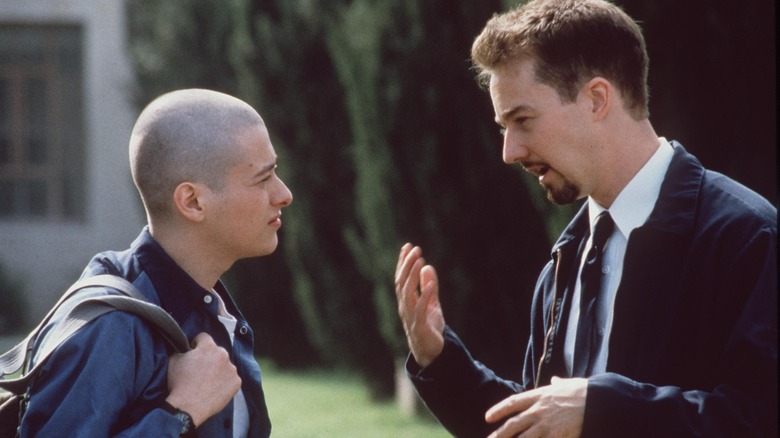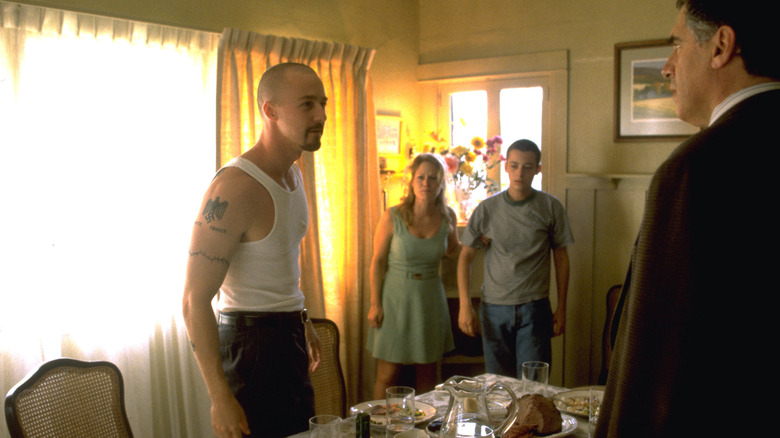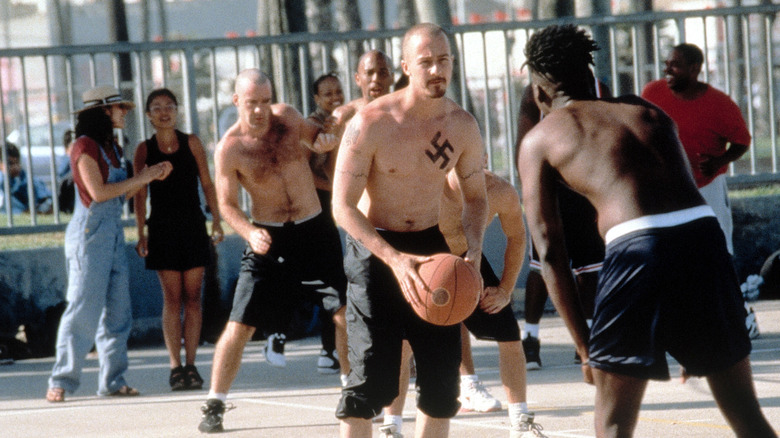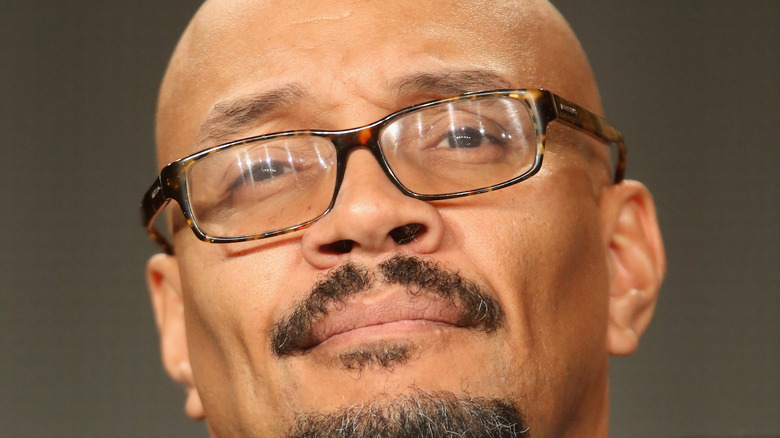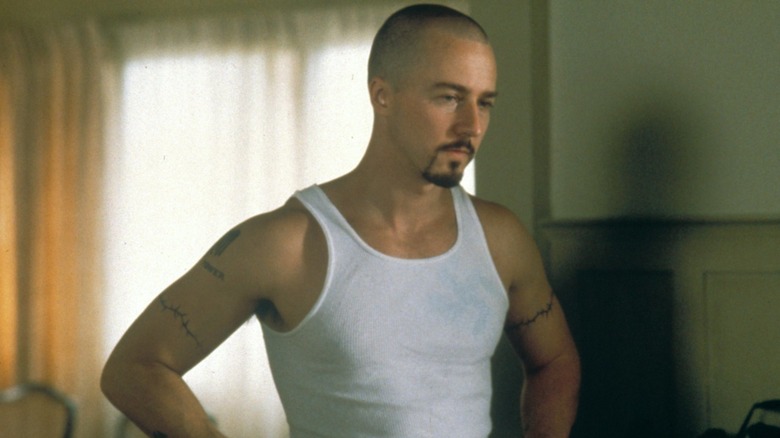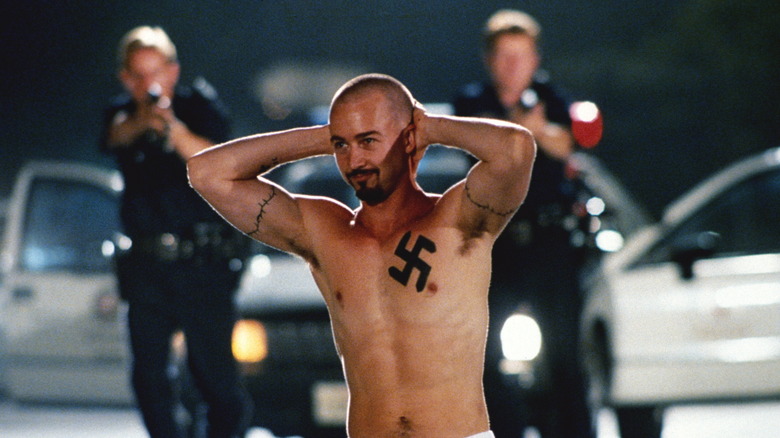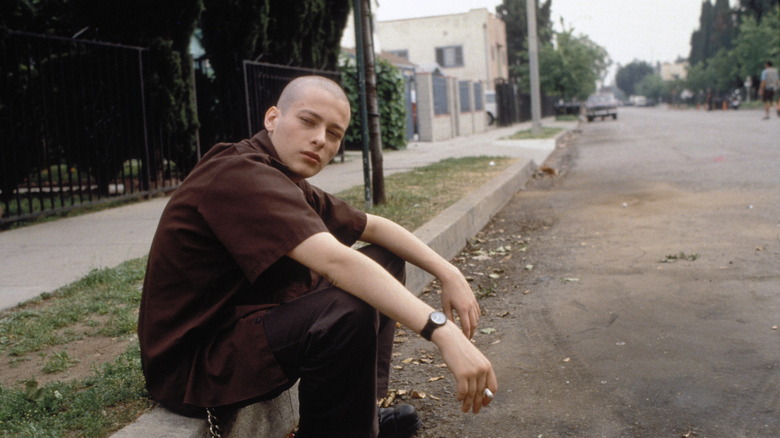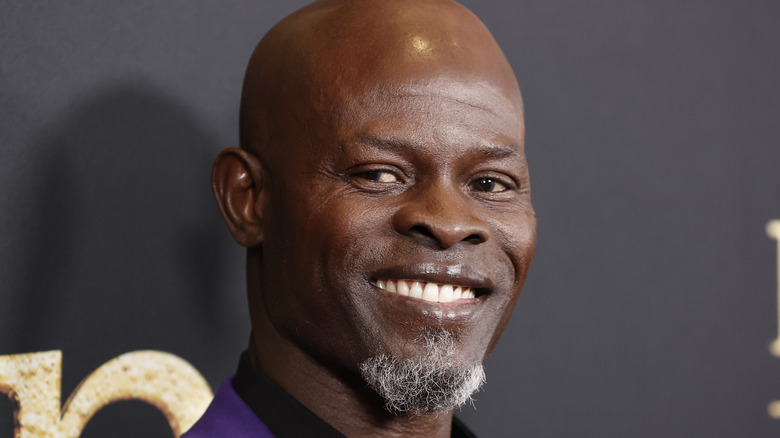The Untold Truth Of American History X
Any film that tackles the subject of racism is an intrinsically uncomfortable, challenging watch. When the film is told from the perspective of a neo-Nazi, it becomes even harder to empathize with the protagonist.
Upon its release in 1998, the raw, visceral, unsettling nature of "American History X" made it a hard-to-watch must-watch. The fact that it was fueled by one of the hottest young actors in Hollywood (Edward Norton was coming off "The People vs. Larry Flynt" and an Oscar nomination for "Primal Fear") and a rebel filmmaker making his directing debut (Tony Kaye, who famously tried to have his name removed from the film and instead credited to "Humpty Dumpty") only made it an even hotter property.
In the eyes of many, the film delivered. Norton's character of white supremacist Danny Vinyard was all the more formidable because he was articulate, intelligent, and charismatic, not the ignorant rednecks of past cinematic race-baiters. Screenwriter David McKenna explained to the Los Angeles Times upon the film's release that his ambition was to move away from racists who were "stupid and moronic rednecks," and create "a story where we could sympathize and maybe understand a radical skinhead who was really smart and organized."
Looking back today, in some ways "American History X" feels prophetic — yet, it would most likely be impossible to get the film made in today's politically-charged, incendiary climate. Which is a shame, because the film's central messages of organized racism's insidious, corrupting, corrosive nature is one that needs to be reinforced, no matter the generation.
In interviews at the time, Norton kept repeating the notion that racists are not born, they are made. "An all-too-common reaction to something like racism is to hate the act so much you dismiss the person," he told The Guardian. "In this film, you're forced to confront the complexity of the character and his tragedy."
David McKenna used real-life material for American History X
The adage of writing about what you know proved invaluable to McKenna when penning "American History X." The screenwriter, whose filmography includes the Johnny Depp vehicle "Blow", grew up in Newport Beach surrounded by Southern California's hardcore punk scene. He would often witness gang fights at the Balboa Pier, and wanted to one day write about the all-pervasive nature of racism because, "In today's society, race is everything."
When fleshing out the characters in "American History X," McKenna talked to a gang of skinheads who he described as products of their environments, their dangerous views typically formed and reinforced in their family homes.
In a 2021 interview, McKenna revealed that he saw "Mississippi Burning" in college and had hoped one day to create something equally as powerful. He recalls writing the script for "American History X" while locked in his LA apartment during the Rodney King riots. Not long after completing the second draft, McKenna and Kaye attended a party where the screenwriter spoke with a neo-Nazi whose head had an M-16 tattoo emblazoned upon it — and none-too-subtly told McKenna he'd better keep his portrayal factual rather than filled with caricatures.
American History X was Kaye's movie debut
According to McKenna, Dennis Hopper was in the running to direct "American History X," but the one million dollars he was demanding was way out of their budget. So, the filmmakers turned to a newcomer, albeit one with every bit the incendiary, off-the-rails creative process of Hopper.
"Tony had only done commercials, but his reel was like nothing I had ever seen," McKenna told the Los Angeles Times in 1998. "I liked the fact he was British and somewhat insane. I just didn't know the extent of his insanity."
According to The Telegraph, not long after shooting for "American History X" had concluded, Kaye was already speaking of himself in terms of "the greatest English director since Hitchcock." Yet such world-beating confidence was not altogether unjustified. Kaye had already made his name as a maverick talent in the realm of music videos and television advertising, where his work has since taken on near legendary status.
In 2002, Kaye wrote in The Guardian that when he left London for the Hollywood Hills he believed he was "following in the footsteps of legends like Von Stroheim, Welles, and Coppola," and "I had been preparing for that first film for 14 years." Yet, he soon learned that Tinseltown wasn't an easy mistress. Instead of being the launching pad of a prolific, dazzling movie career, the complicated aftermath of "American History X" helped handicap the promising director's career.
Kaye, who refers to himself as a "pirate" who was "untouchable in all my film-making endeavors," admits that in post-production "everything fell apart, including me."
Kaye wasn't crazy about Norton
Edward Norton gave several early, career-defining performances ("Primal Fear," "The People vs. Larry Flynt," "Fight Club") that seemed to announce him as an emerging generational talent on par with heavy-hitting, game-changing names like Brando, Pacino or Daniel Day-Lewis. Among these — and particularly impressive as a contrast to those other films — is his "X" portrayal of Vinyard.
Delivering an emotional intensity and nuanced transformation that makes the character feel lived-in, horrifying and ultimately someone the audience feels attached to is something few actors could hope to pull off. He received an Academy Award nomination for best actor, but according to Tony Kaye, he was not the ideal choice to take the lead.
In 2002, the director insisted that Norton's casting was because he was "Hollywood's golden boy." Kaye reveals that he didn't think Norton had the necessary "weight or presence" to do the role justice. Kaye explained, "I held some open casting calls but I couldn't find anyone better than him."
Kaye added that the one advantage of having Norton on board was that he shared the director's vision that the script could be better. Kaye stresses that he believes the screenplay New Line sent him was full of flaws, but he was confident that he could, "maneuver around it: invent stuff, improvise, improve what was on the page." Kaye believed that "In casting him, I was really buying another writer."
In 2019, Norton said in an interview that he nearly didn't make the film, but of all people, it was Francis Ford Coppola who talked him into it.
"If you do that now, they'll never know what to do with you," Norton recalled Coppola telling him at the time. "They'll never be able to put you in a box."
Norton found the making of American History X tough
Playing such a rage-fueled figure would be an exhausting process for even the most thick-skinned actor, but for someone like Norton — who at the time was forging a reputation for getting under the skin of any character he inhabits — it was particularly difficult.
"Making "American History X" was really hard — it was a guerilla kind of experience," the actor said in a 2014 interview with Dan Rather; still, he said, he felt that the early films in his career were something special. "Sometimes you get a sensation in the midst of doing something that — we're making this for us. This is gonna be for our friends, for the people our age. We're onto something here that feels generational ... maybe our parents won't even understand, but our friends will ... if you get to do a couple of [those], you're very fortunate."
To get there, however, Norton had to grapple with tremendous emotional demands, as well as a rigorous physical transformation.
"I knew this guy was going to have to be really physically fearsome, and that's not something anyone would peg me for," he told The Guardian in 1999. "This character is a kid who basically wants to cry and covers it with anger. Defined by rage, arming himself against his own emotional pain — and the body he's created is the physical manifestation of that."
Kaye hung around skinhead clubs before shooting
Once he was committed to the movie, Tony Kaye believed that for "America History X" to be powerful enough to make even committed racists question their beliefs, he would have to be willing to go places where angels fear to tread. The Jewish Journal reported in 1998 that before filming he often hung around skinhead clubs, spent time with the singer of the neo-Nazi band Extreme Hatred, and even conducted numerous interviews with the leader of the White Aryan Resistance, Tom Metzger. Kaye reportedly would turn up to the interviews in a Lincoln Towncar (the "Jewish Car," according to the Journal), with a license plate reportedly emblazoned with the word "Jewish."
According to the profile, Kaye grew up in the Jewish faith, his family bearing scars from a long history of suffering at the hands of fascists. Just before the Holocaust reached Danzig, Kaye's grandmother had ended her life by drowning. His father, then a 12-year-old, escaped the Nazis and fled to England. Kaye experienced prejudice firsthand when a British fascist publication branded Kaye, who was shooting TV commercials at the time, as being part of a shady network of Jewish individuals who control the media.
Considering offense to be the best defense, Kaye created a performance art piece called "Jewish Car for Sale," to challenge people's preconceptions of racism. He explained he wanted "American History X" to do the same on a larger scale.
Ultimately, Kaye believes the film was a failure — Norton, however, disagrees. "We set out to provoke thoughtful discussion about certain issues," he says. "And Tony has succeeded in doing that, whether or not he wants to claim it for himself."
African-American directors voiced concerns
Due to the inflammatory dialogue and themes of "American History X," scriptwriter McKenna has said in interviews that everyone was afraid of his script. After being turned down by New Line Cinema twice, studio president Mike De Luca finally gave it a green light, although New Line harbored concerns that the racist characters in the film could easily be misinterpreted and, in the worst-case scenario, put on a pedestal by certain audiences. To prevent this from happening, executives from New Line consulted with Black directors to get their take.
"New Jack City" director (and son of a legendary Blaxploitation director) Mario Van Peebles, as well as "Tales From The Hood" director Rusty Cundieff were among them. Both were initially critical of what they perceived as a slanted perspective of the racial tension within the film.
"I didn't call them up and say, 'Hey, guys, you have a racist script,' but I did say there was a problem," Cundieff would recall. "Not being Black, the screenwriter may have had trouble stating the Black character's point of view. He's created a powerful character, but when you make the film from the point of view of a character who's evil, you have to walk a real tightrope or the film could really misfire."
Punk band Anti-Heroes attempted to sue
One of the most horrifying white supremacists in "American History X" is Seth Ryan, played by Ethan Suplee. Although a minor character, Seth personifies hatred and a dangerous intellectual complacency. Eagle-eyed viewers may have noticed he also sports a tattoo that reads "The Anti-Heros."
Although the Anti-Heros were a real band from Atlanta and part of the so-called "Oi!" movement, they were, in the tradition of the original skinhead movement, vocally anti-racist. Consequently, they objected deeply to the portrayal of a neo-Nazi on screen with a tattoo berating their name, and filed a $25 million lawsuit against New Line Cinema."
"Here's what happened," lead singer Mark Noah said in an interview about the suit. "New Line asked our record label at the time, Taang!, if they could use our logo, our poster and music for 'American History X.' When Taang! asked us, we said absolutely not. So the movie comes out, and there's an Anti-Heros tattoo left on the biggest Nazi in the movie."
In response, New Line has reportedly taken steps to remove the tattoo from the film. The Anti-Heros, however, made their continued feelings of resentment known via a song called "NLC" that referenced New Line Cinema in ... well, not the kindest of terms.
Norton was responsible for the final cut
Edward Norton didn't just bring a no-hold-barred performance to "American History X"; he also edited the final version of the film.
In 2002, Kaye told The Guardian that the first screening of the movie was a success, but then the studio and Norton began sending him notes on how it could be improved. To say Kaye didn't handle this well is an understatement.
"Their first reaction after I bawled them out was to ban me from the cutting room," he said. "Eventually they let me in, and I worked with them on re-edits for a year. In that time, I found a whole new film, one that they never allowed me to finish. At one point, they even let Norton work on the editing. I was so staggered by what he was doing to my film, and by the fact that New Line approved, that I punched the wall and broke my hand."
The officially-released version of "American History X" would be 40 minutes longer than Kaye's version, and featuring a different ending. Kaye would accuse Norton of generously indulging himself with more screen time and said, "I had done a hard, fast, 95-minute rough diamond of a picture. But the movie they put out was crammed with shots of everyone crying in each other's arms."
McKenna remembers things differently. In a 2021 interview, he explained that although Kaye had shot a great film, he was unable to do it justice in the editing suite. He added that everyone involved asked Norton to take over the editing duties and the actor, "cut the film according to the script with Jerry Greenburg, and rescued our child from an abusive father."
Kaye attempted to disown American History X
Kaye freely admits that he had a huge meltdown when he discovered that his vision for "American History X" had been tampered with, and in retrospect, it's clear he didn't do himself many favors.
"I was being a nightmare to New Line. I had started communicating exclusively through advertisements in the trade papers. I would say whatever I needed to say to them in a full-page ad in Variety or the Hollywood Reporter, sometimes quoting Lennon or Shakespeare; sometimes trumpeting myself as the greatest British director since Hitchcock wrote in The Guardian in 2002. "De Luca responded on one occasion — he placed a copycat ad with a Dr Seuss quote. There was an enormous stir when Terry Gilliam ran a single Variety ad back in 1984, asking the head of Universal when he was planning to release 'Brazil.' But I placed nearly 40 ads. In my eyes, it was the biggest, bloodiest fight in Hollywood since 'Citizen Kane.'"
In one meeting with New Line studio executive De Luca, he engaged the services of a priest, a rabbi, and a Buddhist monk, none of whom had seen "American History X," to be present at the meeting. Kaye wrote in The Guardian, "It sounds preposterous now, but I was looking for some help from God — anything that would give me the 10 extra weeks I needed to recut the picture." Kaye also managed to pull the movie from the Toronto Film Festival much to his studio's displeasure.
Famously, Kaye attempted to disown the film by demanding that his name be removed from the credits and replaced with "Humpty Dumpty." New Line refused, and Kaye launched a lawsuit against them and the Directors Guild of America. Kaye was reportedly suing for $200 million in damages. U.S. District Court Judge Dean D Pregerson denied the claim "with prejudice" and DGA attorney Ernie Getto said, "This is a case that should not have been allowed to move forward on its merits." It wouldn't be the last lawsuit in Kaye's tempestuous career.
Tony Kaye has plans for a new film called African History Y
Despite once lamenting he was in "director's jail," Kaye (who has only put out one significant film, 2011's "Detachment," since "American History X") announced in 2020 that he was planning to return to the hot seat with a project called "African History Y."
According to the Deadline report at the time, Kaye has been writing the script alongside Charles Chanchori and Jason Corder. The film is set to star "Blood Diamond" actor Djimon Hounsou, who said, "I'm excited to be working with Tony, and it's somewhat pre-ordained that he and I have come full circle to work with each other."
Kaye explained that he instinctively knew upon his first meeting with Hounsou that the Oscar nominee was an actor he was compelled to work with. "The material had to be right, and thank God, now we have a project to work together on," he said.
The plot remains largely a secret (it is described as "a story of tragedy and redemption"). As such, it remains to be seen whether "Y" is a proper sequel to "X" — and if Kaye can redeem himself by revisiting the most tempestuous chapter of his life, or will once again fall.
